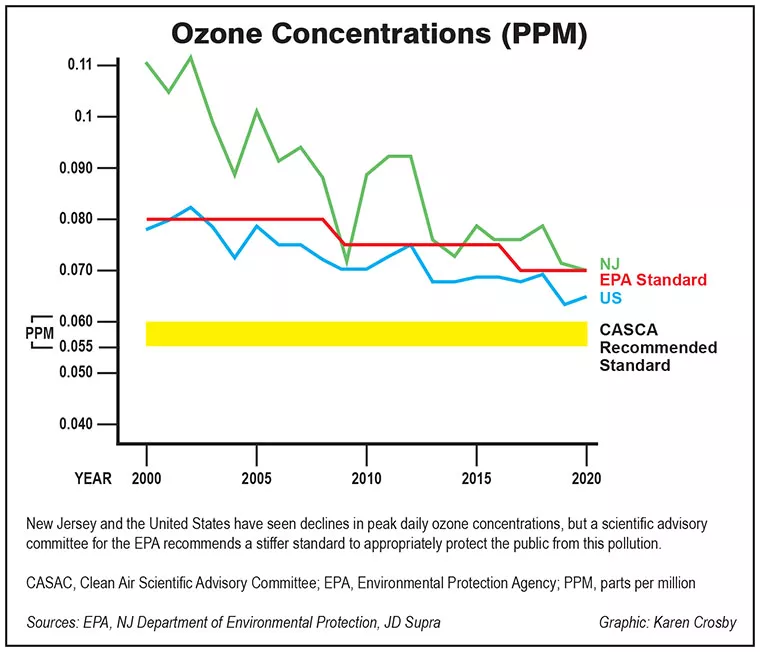By Greg Gorman, Conservation Chair
Ozone is an invisible, odorless gas. In the upper atmosphere it is essential for life as it shields the Earth from the sun’s harmful ultraviolet rays.
At ground level, though, ozone is toxic to life. “Good up high, bad nearby” is the phrase some scientists use. In fact, ozone is one of the most toxic air pollutants.
Ground-level ozone irritates the entire respiratory tract, triggering chest pains, coughing, nausea, throat irritation, and congestion for all animals. In humans, it aggravates medical conditions such as bronchitis, heart disease, emphysema, and asthma, and it can reduce lung capacity. Children are especially at risk because they breathe more air per pound of body weight than adults and tend to be active outdoors during the summer when ozone levels are at their highest.
Ozone does more damage to plants than all other air pollutants combined, according to the US Department of Agriculture. One recent study predicted that by 2050, harvests of wheat would decline by 13%, soybeans by 28%, and corn by 43% because of rising temperatures and ozone. Ground-level ozone damages are responsible for about $1 billion in reduced crop yield in the United States each year.
Because ozone harms public health and the environment, the Clean Air Act requires the Environmental Protection Agency (EPA) to set national ambient air quality standards (NAAQS) for ozone.

When discussing climate change, we typically think of carbon dioxide and methane, rarely mentioning the ground-level ozone “precursor” nitrous oxide, the third-worst greenhouse gas. Ground-level ozone is formed by pollutants—nitrous oxide and volatile organic compounds—that are emitted by cars, trucks, refineries, and power plants. When these air-borne pollutants meet sunlight and warm temperatures, they go through a chemical reaction and become ozone.
Worldwide, ground-level pollution is on the rise because of increased fossil-fuel consumption and increased sunny days because of climate change.
Ozone pollution is accelerated by and contributes to climate change.
Ground-level concentrations in New Jersey and the nation reflect a downward trend since the mid-‘90s (Graphic).
The American Lung Association’s 2018 State of the Air report, based on the three-year period from 2014-2016, identified 10 NJ counties as failing to meet NAAQS standards for ground-level ozone. The 2023 State of the Air report, based on 2019-2021 data, identifies only two counties as failing (Bergen and Mercer). Despite this improvement, ground-level ozone remains a health threat, and the existing NAAQS standard is not low enough.
The EPA is presently reviewing the ozone standard with final recommendations expected in the spring of 2024.
Preliminary commentary submitted by the Clean Air Scientific Advisory Committee (CASAC) recommends lowering the ozone standard from 70 parts per million (ppm), established in 2015, to 55-60 ppm. The Sierra Club applauds this recommendation.
The EPA labels New Jersey as a “nonattainment” state—it has too much ozone—and requires a state implementation plan (SIP) for achieving NAAQS. The 2017 SIP relies on a regimen of federal and state regulations to reduce emissions of nitrous oxides and volatile organic chemicals (VOCs) for automotive and stationary sources. To attain the ozone standard, the 2017 SIP recommends the federal government strengthen regulations for diesel engines as well as enforce ozone regulations on out-of-state sources. The 2021 SIP commits the state Department of Environmental Protection to investigate new control measures to:
- Adopt California Air Resource Board (CARB) prohibitions on the sale or installation of any aftermarket catalytic converter unless these are certified via a CARB executive order or meet requirements for emissions, durability, and other standards imposed on original equipment manufacturers. This will result in NOx reductions of about 3 tons per day.
- Incorporate rules to control VOC emissions from architectural and industrial maintenance coatings. The proposed rules will lower the VOC content for several coating categories.
- Incorporate rules to limit VOCs for several new categories of products and lower the VOC limits for several existing categories of products.
What better way to reduce groundlevel ozone than to stop burning fossil fuel! The 2021 SIP highlights clean energy and climate change initiatives ranging from offshore wind, the return to the Regional Greenhouse Gas Initiative, and the strengthening of New Jersey’s Renewable Portfolio Standard by requiring 35% renewable power by 2025 and 50% renewable power by 2030. The 2021 SIP also addresses commitments for electric vehicles, creation of a regulatory roadmap to reduce emissions, resilience building, and adaptation to a changing climate to reduce emissions of methane and ozone precursors, along with other transportation initiatives.
The quicker we deploy clean energy and reduce ozone levels, the quicker we can improve public health and our environment.
Resources
Yale Harvest Report: https://shorturl.at/HMVY0
CASAC Recommendation: https://shorturl.at/hpxzY
NJDEP 2021 SIP: https://shorturl.at/dmvxY